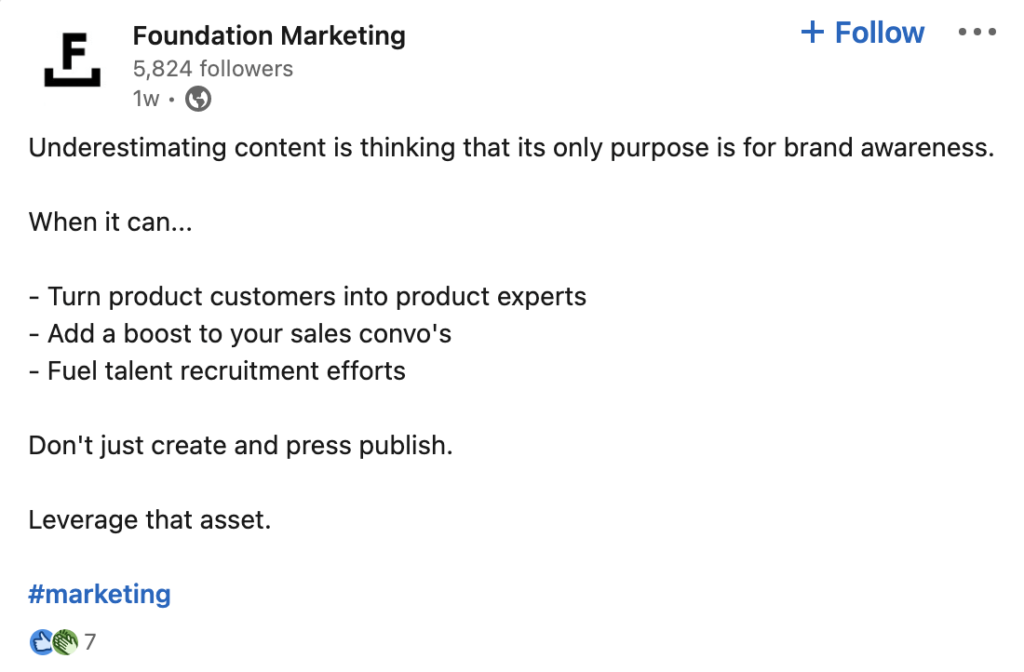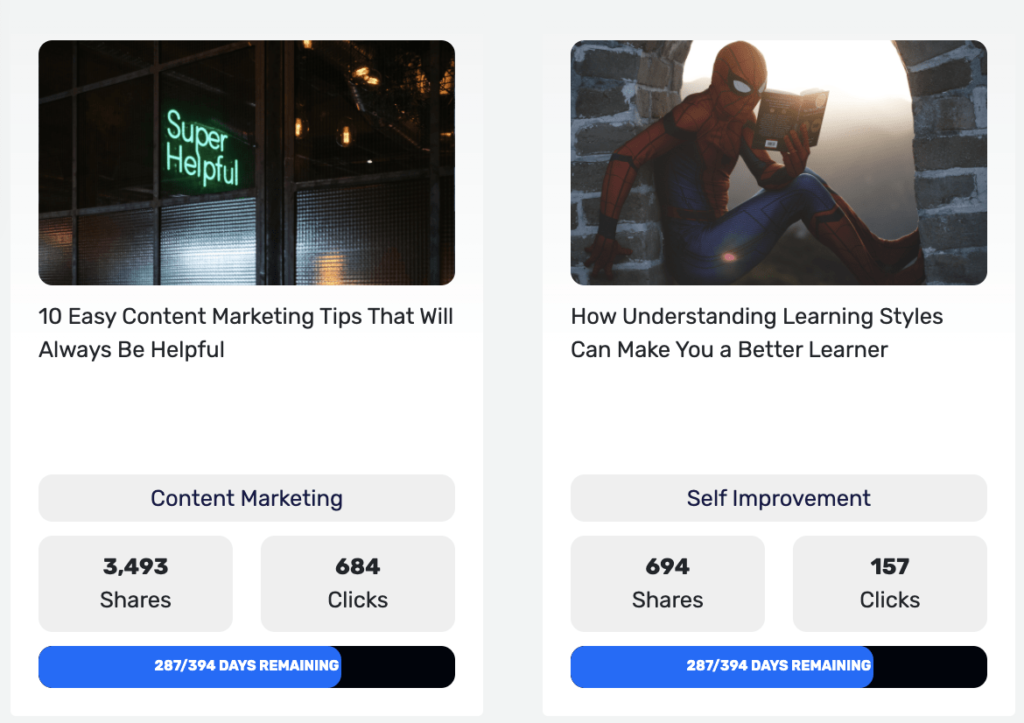Marketing agencies are so busy creating content for their clients, they don’t prioritize creating content for themselves. And if an agency that employs a whole team of people who don’t have time for marketing, where does that leave the freelancing solopreneurs of this world?
In this post, I want to persuade both agencies and freelancers that their own marketing is a worthwhile investment of their time by looking at real-life examples of businesses that have used social media to get new clients. We’re going to focus on social media, in particular, because it’s one of the most accessible and effective channels for building a brand.
To make my case, I asked freelancers and agency founders/employees in my network to share times when they’ve landed a new client as a direct result of social media. Every single person who took the survey had not just one, but multiple anecdotes to share.
Grouping these together, I started to see some clear patterns emerging. From my research, I’ve identified 4 proven methods to get new clients through social media, with plenty of amazing stories to back them up.
4 ways you can use social media to get new clients
1. Share content
There are lots of benefits of creating your own content when you’ve got a service to sell: it proves your expertise, earns the trust of your audience, drives conversations, and makes your brand easily identifiable in the sea of faces online. Social media offers freelancers and agencies lots of chances to get their content seen by their target audience, so try sharing the following types of content.
Blogs and articles
Foundation Inc is one of my favourite B2B marketing agencies right now, mainly because they always publish insightful, helpful and original content on their blog. Therefore, it was no surprise to hear from Taru Bhargava, Foundation’s Content Marketing & SEO Specialist, that it drives a large portion of their client acquisitions.
It’s through social media, not via their website or email, that clients reach out to them:
“We develop a lot of content for our agency blog and promote it extensively via social channels, especially LinkedIn. As a result, a lot of our team members get approached with inquiries through [LinkedIn]. B2B Brands see the kind of effort we put in developing and distributing content for our internal brands and are very keen to work with us. Not to give out names, but we’ve got some great client associations that way.”

Patrick Hodgdon, Founder and Chief Storyteller at StorySprints also recommends this strategy:
“Each of the last four founders that became Story Sprints clients I connected with as a result of my activity and sharing content on LinkedIn and Twitter. One was a referral from a different founder that had seen some of the content I had been sharing.”
It’s worth noting that there are other options besides sharing your own content. As long as you have their permission, you could showcase the content you’ve created for your clients, like Jordie Black, Content Marketer at Copy and Check:
“We actually acquired one of our longest-standing customers through LinkedIn. We often share our clients’ work on there. Our new client reached out to our existing client, as they liked the tone of voice of the content and wanted to see if they were working with an internal or external writer. An introduction was made, and the rest was history, as they say.”
Video content
Video is one of the best ways to expand your reach and drive engagement on social media. In fact, Josh Braaten used it to launch a brand new side project for his business:
“We produce a weekly video series as part of our inbound marketing efforts. Recently, a new client came to us and asked if we would help them produce a web series of their own. It’s not our main area of focus, but the project was too interesting to pass up.”
Remember that your own content gives potential clients a preview of what you can do for them, so make sure it’s high quality. If you’re looking for inspiration for how to use video content as an agency or freelancer, check out Social Chain and Goldie Chan (LinkedIn is a really strong channel for video right now).

Straight-up social media posts
Feeling overwhelmed by the prospect of publishing regular blog or video content alongside your client work? Sometimes, all it takes is a simple, native social media post.
“I try to post something thought-provoking on LinkedIn once a week. Sometimes it’s about a particular test that I’m running or a tactic that I see working. This will often lead to one of my connections (or second tier contacts) reaching out to me to see if we’d be a good fit for a project. And often we are,” said Jason Thibault, Founder at Massive Kontent.
When I interviewed Online Course Specialist, Paul Thomson, for Quuu’s podcast, he revealed that social media was his primary acquisition channel in the initial stages of growing his business.
Alongside sharing your own tips and ideas, curating content from reputable publications and people is a great way to establish yourself as a trusted source of information in your industry. Set up Google Alerts, create Twitter lists or use a tool like Quuu to find relevant content for your audience.
2. Get other people to share your content
When other people share your content, it not only increases reach, but it also boosts your credibility.
Anca Dumitru, a self-employed content strategist acquired a new client when her article was shared on social media:
“A while ago, I had written an article for one of my clients for which I interviewed the founder of a Chicago-based digital marketing agency and she shared the article link on LinkedIn. One of her network contacts (also from Chicago) saw it. He liked it and sent me an invite to connect along with a brief message. He needed help with bringing awareness to his organization and clarifying his message. Long story short we had a quick chat and we ended up working together very well.”
If you’re creating high quality content tailored to your audience’s needs, it should generate shares organically. Having said this, there are a few things you can do to give it a gentle nudge in the right direction.
For starters, simply email influential people in your network politely asking them to share your content; this could be colleagues, existing clients, people who’ve contributed to the content (e.g. for an expert roundup post), friends in your industry, and other contacts. Some Slack communities also have dedicated promotion channels where members share each other’s content.
Of course, we couldn’t talk about content promotion without mentioning Quuu Promote, where you can submit your content to be shared on social media by real people in your niche.

3. Join groups
We’ve just touched on the value of Slack groups for promoting content, and as the social media landscape evolves, private communities are becoming increasingly important. Joining highly engaged Facebook groups, LinkedIn groups, Slack communities and Twitter chats can help you meet and build relationships with potential clients.
Check out Jason’s story:
“While connecting to dozens of members of a particularly active Facebook group, one of my new connections happened to own a successful marketing agency. He wanted me to help out with promoting a huge article that he was ready to publish. That turned out to be a success and we remain working together to this day.”
It’s essential that you don’t approach these communities with a selling mindset. Moderators will often put in place strict rules against self-promotion, so focus on providing genuine value to the rest of the group, then exciting opportunities will naturally follow.
4. Start conversations
Once you’ve joined and started participating in relevant online communities, make sure that you’re investing in one-on-one relationships, as well as group discussions. Just look at how a single tweet powered freelance writer Kaleigh Moore’s entire career:
“My very first client as a freelancer came through Twitter! I reached out and complimented a fellow writer’s blog post about freelance portfolios, and she tweeted back some nice words about the eCommerce store I had at the time. I sent her a free piece of jewelry and we continued the conversation in email, chatting more about freelance writing. She happened to be working at a software company at the time as the editor of their blog and needed freelance support, and asked if I was up for writing a few posts for them. Voila! My referrals in the SaaS niche grew from there.”
As social media communities become more exclusive, we’re also seeing a growing emphasis on private messaging. Again, don’t approach this with the intention to sell, but be aware of its potential as a marketing channel:
“I keep ongoing months-long conversations with several agency owners via LinkedIn messaging. 99% of the time we keep it light and talk about our day-to-day activities, but once in a while, we refer work to each other,” says Jason.
Particularly in younger industries like SaaS, there’s a close-knit circle of people who’ll refer each other for projects and even full time jobs. Hiring often happens through word of mouth, so it’s worth getting to know and supporting your peers (although you should do this primarily to be a nice, friendly human being!).
“I’ve always been active on Twitter – not just engaging with companies I’d love to work with, but with freelancers as well,” says B2B SaaS content writer, Elise Dopson. “This worked in my favour when Databox’s Director of Marketing, John Bonini, put out a tweet mentioning that they’re hiring a freelance writer. Someone who I’d built a relationship with already tagged me in the post to see if I’d be interested. To my surprise, John followed up with me directly, we hopped on a call, and Databox have been one of my best clients ever since.”
Conclusion
Hopefully, these stories from successful freelancers and agency workers have inspired you to use social media to get new clients for your business. To recap, all you need to do is follow these four simple steps:
- Share content you’ve created on your social media profiles (your own blog posts, content from your client portfolio, video content, or simply helpful social media posts)
- Make sure your content is being shared on social media by influential people
- Join relevant groups and communities in your industry
- Start conversations and build genuine relationships with your peers
You never know what might happen! Has social media helped you get new clients? We’d love to hear your stories.






